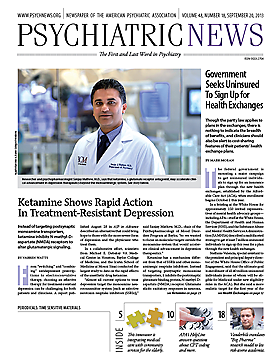I was nothing short of astonished by my experience at the APA Board of Trustees (BOT) meeting in July in Arlington, Va. I certainly anticipated that the BOT would sit indoors for long hours reviewing reams of material. Having prepared for the meeting by reading those reams beforehand alerted me to that. There was debate, sometimes passionate, and lots of humor. That too was expected since I knew several, though not all, of the BOT members. Close attention was paid to parliamentary rules, ensuring that procedure was followed. None of that was terribly surprising, either. What was surprising is just how much work APA does not only for its members, but for our patients—as well as those who may someday need our care.
For example, I had not been fully cognizant of the work that APA is doing to ensure that parity laws are implemented in a way that is truly fair and equitable for our patients. I learned that APA is aggressively pursuing an arduous fight to improve access to care in a strategic and sophisticated manner. APA staff described to the BOT how hundreds of members have voiced complaints regarding implementation of the new CPT codes in ways that potentially violate parity.
In response, APA has been addressing each complaint with the insurers and other payers, some of who immediately changed their ways. As might be expected where money is involved, not all payers have agreed to make the changes that will increase coverage for mental conditions to the same level as other medical illnesses. Indeed, some payers remain defiantly out of line with the intent of the Mental Health Parity and Addiction Equity Act. I was pleased—no, relieved—that APA is in the fray to safeguard our patients’ right to be treated fairly. It is the humane thing to do.
Another issue that the APA BOT addressed is the terrible problem that firearms present for our country. During the meeting, we discussed how the dominant rhetoric in the media relates to understandable concerns that arise when mass tragedies occur. What most of the public does not know is that most gun deaths are due to suicide and murder. Indeed, the suicide rate is up, and in 2010, there were 38,364 suicides in the United States, on average about 105 each day (
http://www.cdc.gov/violenceprevention/pdf/suicide-datasheet-a.PDF). APA is working hard to engage in the public debate on guns to underscore the frequency of suicide as a heartbreaking consequence of having them easily available.
I am pleased that not only does APA concern itself with helping its members and our patients, but also many other constituencies as well—including juveniles in the penitentiary system, many of whom would benefit from mental health care. Amazingly enough, several states have statutes on the books that permit juveniles to be tried and sentenced by adult courts without judicial review of the individual case or assessment of mental or neurodevelopmental issues that may be essential to a full understanding of the situation. Recognizing that neurodevelopmental disorders and mental illness may play a significant role in criminal behavior in children and adolescents, the BOT addressed the fact that many youngsters incarcerated in this country lack access to appropriate and desperately needed mental health care and approved a position statement advocating for these youth. They certainly need all the help and support they can get to ensure the system gives them a fair shake.
I encourage you to get involved with APA, whether at the district branch level or at the national level. There is a lot of work to be done, and we could most definitely use your help and energy. After all, APA is active in addressing issues of critical importance to us! ■

